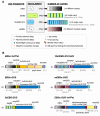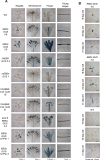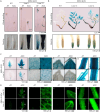This is a preprint.
EBSn, a robust synthetic reporter for monitoring ethylene responses in plants
- PMID: 40501970
- PMCID: PMC12154813
- DOI: 10.1101/2025.05.23.655144
EBSn, a robust synthetic reporter for monitoring ethylene responses in plants
Abstract
Ethylene is a gaseous plant hormone that controls a wide array of physiologically relevant processes, including plant responses to biotic and abiotic stress, and induces ripening in climacteric fruits. To monitor ethylene in plants, analytical methods, phenotypic assays, gene expression analysis, and transcriptional or translational reporters are typically employed. In the model plant Arabidopsis, two ethylene-sensitive synthetic transcriptional reporters have been described, 5xEBS:GUS and 10×2EBS-S10:GUS. These reporters harbor a different type, arrangement, and number of homotypic cis-elements in their promoters and thus may recruit the ethylene master regulator EIN3 in the context of alternative transcriptional complexes. Accordingly, the patterns of GUS activity in these transgenic lines differ and neither of them encompasses all plant tissues even in the presence of saturating levels of exogenous ethylene. Herein, we set out to develop and test a more sensitive version of the ethylene-inducible promoter that we refer to as EBSnew (abbreviated as EBSn). EBSn leverages a tandem of ten non-identical, natural copies of a novel, dual, everted, 11bp-long EIN3-binding site, 2EBS(-1). We show that in Arabidopsis, EBSn outperforms its predecessors in terms of its ethylene sensitivity, having the capacity to monitor endogenous levels of ethylene and displaying more ubiquitous expression in response to the exogenous hormone. We demonstrate that the EBSn promoter is also functional in tomato, opening new avenues to manipulating ethylene-regulated processes, such as ripening and senescence, in crops.
Conflict of interest statement
Conflict of interest statement The authors declare that they have no competing interests to disclose.
Figures







Similar articles
-
Signs and symptoms to determine if a patient presenting in primary care or hospital outpatient settings has COVID-19.Cochrane Database Syst Rev. 2022 May 20;5(5):CD013665. doi: 10.1002/14651858.CD013665.pub3. Cochrane Database Syst Rev. 2022. PMID: 35593186 Free PMC article.
-
Systemic pharmacological treatments for chronic plaque psoriasis: a network meta-analysis.Cochrane Database Syst Rev. 2021 Apr 19;4(4):CD011535. doi: 10.1002/14651858.CD011535.pub4. Cochrane Database Syst Rev. 2021. Update in: Cochrane Database Syst Rev. 2022 May 23;5:CD011535. doi: 10.1002/14651858.CD011535.pub5. PMID: 33871055 Free PMC article. Updated.
-
Behavioral interventions to reduce risk for sexual transmission of HIV among men who have sex with men.Cochrane Database Syst Rev. 2008 Jul 16;(3):CD001230. doi: 10.1002/14651858.CD001230.pub2. Cochrane Database Syst Rev. 2008. PMID: 18646068
-
Factors that influence the provision of intrapartum and postnatal care by skilled birth attendants in low- and middle-income countries: a qualitative evidence synthesis.Cochrane Database Syst Rev. 2017 Nov 17;11(11):CD011558. doi: 10.1002/14651858.CD011558.pub2. Cochrane Database Syst Rev. 2017. PMID: 29148566 Free PMC article.
-
Nutritional labelling for healthier food or non-alcoholic drink purchasing and consumption.Cochrane Database Syst Rev. 2018 Feb 27;2(2):CD009315. doi: 10.1002/14651858.CD009315.pub2. Cochrane Database Syst Rev. 2018. PMID: 29482264 Free PMC article.
References
-
- Abeles FB, Morgan PW, Saltveit ME Jr. Ethylene (2nd ed.). In: Abeles FB, Morgan PW, Saltveit ME Jr, editors. Plant Biology, Academic Press, NY: Elsevier Inc. US; 1992. https://shop.elsevier.com/books/ethylene-in-plant-biology/abeles/978-0-0...
Publication types
Grants and funding
LinkOut - more resources
Full Text Sources
